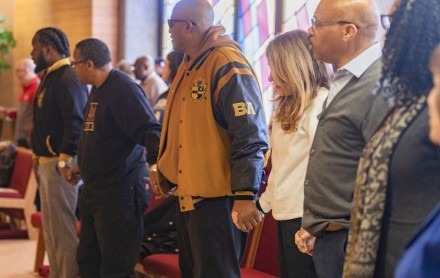Alumna’s Artwork Tells the Story of Kateri Community’s Namesake

One of the first things you see as you enter Kateri Community is now a large ink drawing of two entwined hands, framed by a thick wooden frame. This, believe it or not, is a portrait.
The piece was created by Laura Bryon-Knapp, ’07, specifically for this spot, as a tribute to the namesake of the pair of residential communities on the north side of campus for students interested in Ignatian Catholic spirituality and sustainability, respectively. Its name comes from St. Kateri Tekakwitha, a member of the Algonquin–Mohawk tribe, who became the first Catholic saint of Native American origin and the patron saint of ecology. Her story is one of faith in the face of hardship and of living in the margins, and Bryon-Knapp’s artwork weaves many of the details of both Kateri's life story and personality into it.
The idea of an art piece has long been part of the design for Kateri, said Bill Kriege, director of campus ministry, during a recent dedication and blessing ceremony for the artwork.
“Since the beginning, we wanted to have a special art piece, right as people walked in, to welcome them into the space and into the spirit of this space,” Kriege said.
As one of the founders of Voices for Justice, the campus social justice organization, and having learned of Kateri Community’s mission before it opened, Bryon-Knapp said it was an inspiring project. That said, she admits to being slightly hesitant to take it on at first. For one, she does not consider herself a portrait artist. And she worried that crafting an image for someone of whom no photographs exist would fail to do the subject justice.
“I just couldn’t bring myself to make something like that from my perspective, which would have been possibly a depiction of what I thought a native person would look like or dress like,” she said.
So instead, Bryon-Knapp settled on an image of a pair of hands clasped in prayer and filled that image with references to St. Kateri and her legacy. Within the form of the hands, viewers can spot rosary beads, the lush evergreens of the Northeast Kateri called home, the scars from smallpox that Kateri contracted in her childhood, wampum beads and more. There is also Jesuit-specific imagery and inscriptions faintly visible in the fingernails. Rendered in tiny ink dots that purposely appear blurry from a distance to mirror our own knowledge of who Kateri was, every small part of the work has been considered.
It was a labor of love, the result of research and reflection, and it was about 90% complete when the COVID-19 pandemic hit. During that time at home, with two young children, Bryon-Knapp said she found herself praying to St. Kateri and found calm in the image. Now housed in a frame made from a honey locust tree that had to be removed from the backyard of the building by a team that included Kriege and campus ministry work study Olivia Wilmsmeyer, Bryon-Knapp said she hopes the piece serves a similar purpose for others.
“This piece is meant to be a true meditation, and I felt it was a moving meditation while making it,” she said. “It is my hope that viewers find this meditation, drift into thought and intentional prayer and use it as a contemplation piece.”



